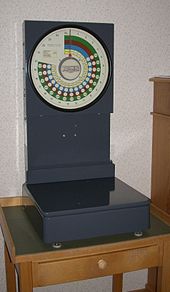Spring balance
The spring scales (also known as bag scales) and the spring dynamometer are measuring devices that use the elongation of a helical spring to measure a force . The spring balance determines the mass via the weight force and has a scale in kilograms (kg). The dynamometer scale is given in Newtons (N).
The principle
The spring balance uses the linear and elastic expansion of a helical spring under the action of a tensile force to measure tensile or weight forces . The length expansion is measured, which is proportional to the tensile force in the linear expansion range of the spring according to Hooke's law . For practical use, a helical spring is provided with a suspension or fastening device at each end and a scale and a pointer along the spring path. More complex designs, so-called pointer high-speed scales, consist of a housing with a circular scale and a corresponding pointer. Behind the dial are usually two helical tension springs, at the lower end of which a load-bearing hook is mounted that protrudes from the scale housing. The movement of the pair of springs is transmitted to the pointer axis by means of a rack and pinion. Usual load capacities and scale divisions: 10 kg / 50 g, 25 kg / 100 g, 50 kg / 200 g, 100 kg / 500 g, 200 or 300 kg / 1 kg.
There are also high-quality bench scales with a large circular pointer measuring head for use in industry, trade and laboratories that work according to the spring balance principle. This is i. d. Usually solid devices in heavy metal housings with large displays behind glass. The usual weighing ranges and scale divisions are 25 kg / 50 g, 50 kg / 100 g and 100 kg / 200 g, whereby an estimated reading between the scale divisions is usually still possible and sufficiently accurate. Today (2011) these scales are only built by very few manufacturers. They found widespread use in post offices / branches, canteen kitchens, workshops and laboratories and were or are valued for their uncomplicated handling (sliding weights have to be operated on sliding weight scales, electronic scales have to be switched on and off again).
"Suitable" for the respective measurement purpose is a spring which, on the one hand, allows a force to be exerted in the desired order of magnitude over the range of its reversible expansion and, on the other hand, has a linear relationship between force and path along the intended spring travel , i.e. H. can be characterized by a spring constant .
If a body is hung on the lower end of a suspended spring balance, the spring is stretched under the action of gravity and the weight or - due to the spatial factor in the scale - the mass of the body is displayed.
When determining the mass with a spring balance, it should be noted that the magnitude of the acceleration due to gravity differs locally according to both geographical and topographical location (hence the term location factor). A spring scale calibrated to weight under 45 ° width shows z. B. at the equator by 0.26% too little, but near the poles by 0.26% too much. On the moon , the corresponding display value would be only one sixth of that on earth. Scales with counterweights do not have this effect; on the other hand, only spring scales are suitable for gravity determinations.
Measurement accuracy
The measuring accuracy of simple tubular models is usually not great; it is negatively influenced by structural features (friction, clamping of the spring in the housing), too coarse or too small scale divisions and unfavorable readability (small digits). Hanging scales with a circular pointer instrument are easier to read. The above-mentioned large table scales represent the particularly high-quality design and are usually specified by the manufacturer with an accuracy of 0.2% of the full scale value, but show practical accuracies of 0.1% of the full scale value with careful handling and regular maintenance. Compared to the simple models, their accuracy and manageability are favored by more complex processing, higher quality materials, more careful adjustment as well as lever mechanisms mounted in hard metal cutting edges and vibration damping (oil dampers).
Force gauge for technology and physics
See main article force measurement .
- The gravimeter is a precision "spring balance" (inclined beam) for geophysics and geodesy . This determines the earth's gravity field (9.5 to 9.9 ± 10 −8 m / s²).
- Ring dynamometer for measuring mechanical tensile and compressive forces
- Rotary balance (torsion balance) for determining the gravitational constant (1798)
See also
- Libra
- Photon balance - thought experiment by Albert Einstein
Web links
- http://www.admin.ch/ch/d/ff/2002/2607.pdf (approval for calibration; PDF file; 31 kB)
- Force gauge with images ( LEIFI )
- Christof Windgätter: "On the Historiography of the Dynamometer"



